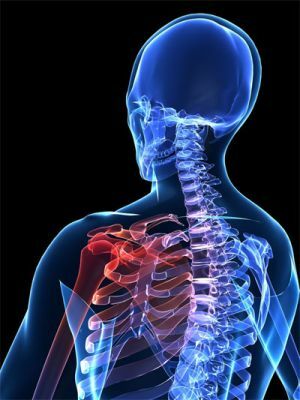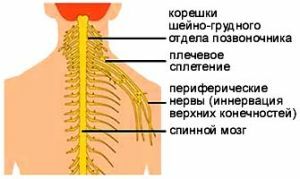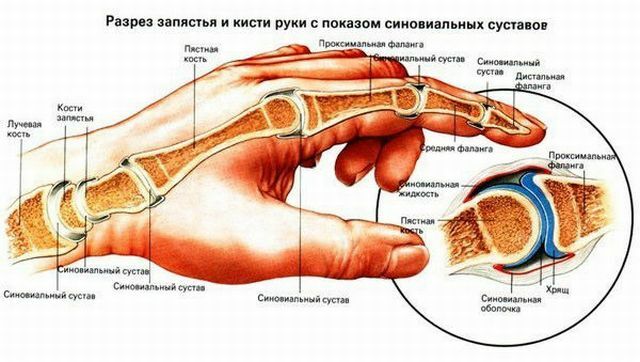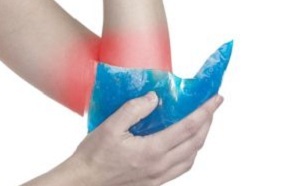 Brachialgia( brachialgia) in Greek means pain in the shoulder region. Painful sensations in the upper limbs occur for many reasons, so it is very difficult to determine the true focus of the disease.
Brachialgia( brachialgia) in Greek means pain in the shoulder region. Painful sensations in the upper limbs occur for many reasons, so it is very difficult to determine the true focus of the disease.
The main feature of the brachialgic syndrome is that it is practically inseparable from painful sensations in the shoulder and neck area.
Characterized by pain, weakness, numbness of the upper limbs, inflammation of the hand and neck.
Contents of the article
- The details of the syndrome
- The main causes of the development
- Complex of symptoms
- Diagnosis of the disease
- Treatment of the syndrome
- Treatment of concomitant diseases
Details about the syndrome
Brachialgia causes a process that is localized in any part of the locomotor system of the body. From the spinal cord to the limb sections.
Cervical-shoulder localization occurs most often. The whole organism is an interconnected system, the violation of one part leads to failures in the other. Especially when it touches the spine.
The second feature of the disease is sensory impairment. There are problems when trying to raise your hand up, to the side, to move your fingers.
There is no special section devoted to this disease in the international classification of ICD-10 disease. It belongs to the XIII class M00-M99 "Diseases of the musculoskeletal system and connective tissue".
The main causes of the development
Patients with brachialgia combines the kind of activity.
This can be work on the computer, the constant movement of any objects, lifting of gravity, the performance of written assignments. That is, everything that is associated with prolonged neck tension in a certain position.
The syndrome is characterized by a wide variety of etiological factors.
In practice, it is difficult to establish the causes and the relationship between the symptoms and the source of occurrence.
For example, the brachial syndrome is a consequence of cervical radiculopathy, which resulted from damage to the motor segments of the vertebrae
Complex of symptoms
Symptoms of the disease are complex. The most striking symptoms of brachialgia are:
- Presence of pain .It can be a burning pain, aching, bursting and is combined with other sensitive disorders.
- Vegetative-trophic disorders .There is a discoloration of the skin, pigmentation, cyanosis, edema, osteoporosis, increased sweating. There is a disruption in the growth of nails and hair.
- Motility disorder .Moving the upper limbs becomes problematic, especially when you need to lift them up.
So, the obvious symptoms of brachialgia are the presence of pain of a different nature, tingling and numbness of the limbs, a violation of sensitivity and motor skills. Most patients complain of weakness and pain in the shoulders, forearm, neck and wrist.
Pain sensations increase during motor activity and decrease when in a calm state. At night, there are bouts of pain, which leads to sleep disturbances. As a result, the head begins to ache.
Diagnosis of the disease
In the term "brachial syndrome" different doctors include their meaning.
Some prefer to refer to it inflammatory processes and painful sensations in the cervical nerve root, which can not be diagnosed.
Others associate with the chest exit syndrome, which is easy to detect.
During the disease, a certain pattern can be traced:
- Acute stage of the disease .There is a strong, acute pain with various sensitive disorders.
- The degenerative stage of .There are vegetative and trophic disorders. There is a cyanotic shade, muscle tone rises, body temperature rises at the extremity, tendon reflexes become animated, joint damage and impaired motor activity develop.
- Atrophic or late stage of .During this period, the symptoms of the disease subsided. The skin temperature of the extremities decreases, the color becomes pale, the growth of nails and hair is disturbed, osteoporosis appears.
Before beginning the treatment of brachialgia, an accurate diagnosis of the disease should be performed, which includes:
- a thorough examination of the neck, shoulder, forearm area, reveals or excludes damage;
- X-ray examination of the neck, and from different angles;
- consults with the neurologist;
- angiography or venography, such studies are performed to exclude vascular damage.
 Radiographic images identify possible causes of the onset of symptoms. Back injuries - old and recently acquired, are evaluated by the results of magnetic resonance imaging( MRI) and computed tomography( CT).
Radiographic images identify possible causes of the onset of symptoms. Back injuries - old and recently acquired, are evaluated by the results of magnetic resonance imaging( MRI) and computed tomography( CT).
Spine pathology is detected in the same way. Electromyography( EMG) will help to establish nerve damage. Vascular lesions and thrombosis are detected using venography and angiography.
At general inspection the neck and arms or hand look or appear quite normally. There are painful sensations when touched. There is a strong neck strain and restriction in movement.
An incorrect posture is observed with the head tilted forward, the lowered shoulders and the rounded spine. Symptoms worsen significantly when hands are raised up.
Treatment of
Syndrome Treatment is performed taking into account the identified factors. Painful symptoms are removed with anti-inflammatory and analgesic drugs. With conservative treatment - this is the main goal.
Several methods are used:
- BSEC - percutaneous electrostimulation of nerves;
- cryotherapy;
- heat treatment;
- use of ultrasound;
- elimination of pain symptoms by behavioral and cognitive methods;
- tissue massage.
The following methods are aimed at improving physical activity:
- massage;

- physical exercises for neck and hands;
- stretch exercises for the cervico-brachial region;
- control of posture during the day.
Treatment of concomitant diseases
Brachialgia can cause the following diseases:
- cervical osteochondrosis;
- cervical spondylosis;
- plexopathy;
- epidural abscess;
- neuralgia of the occipital nerve;
- herniated intervertebral disc;
- tumor lesions;
- myofascial pain;
- osteomyelitis;
- fracture and dislocation of the cervical spine;
- meningitis;
- thrombosis or spinal stratification of the spinal artery.
This is far from a complete list of diseases, proceeding from this and treatment with brachialgia is chosen strictly individually.
At home, you can treat those diseases that are diagnosed for certain, as well as chronic ones, which are exacerbated from time to time.
 Brachialgia is a cause-and-effect disease that does not occur in a single day. A variety of causes of the symptoms complicate the diagnostic process.
Brachialgia is a cause-and-effect disease that does not occur in a single day. A variety of causes of the symptoms complicate the diagnostic process.
Treatment is complex and is aimed at reducing pain syndrome and improving motor activity.
Sometimes the cause of the disease is an old trauma to the spine. We need to monitor our body, respond to painful manifestations and start treatment on time.
Thus, it is possible to prevent not only brachialgia, but also many other diseases.



